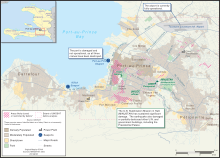
Killick (formerly the Admiral Killick Haitian Navy base; [1] also called Point Killick [2] ) is the Haitian Coast Guard base in Port-au-Prince. [3] It is the main base for the Coast Guard. [4] It is the other port for the city, aside from the main Port international de Port-au-Prince. It is located about 10 miles outside of downtown Port-au-Prince, and is about a century old. [1] The base is named after Admiral Hammerton Killick of the Haitian Navy, who scuttled his own ship, the Crête-à-Pierrot , a 940-ton screw gunship, by igniting the magazine, and went down with the ship, instead of surrendering to German forces, in 1902, at Gonaïves, Haiti.